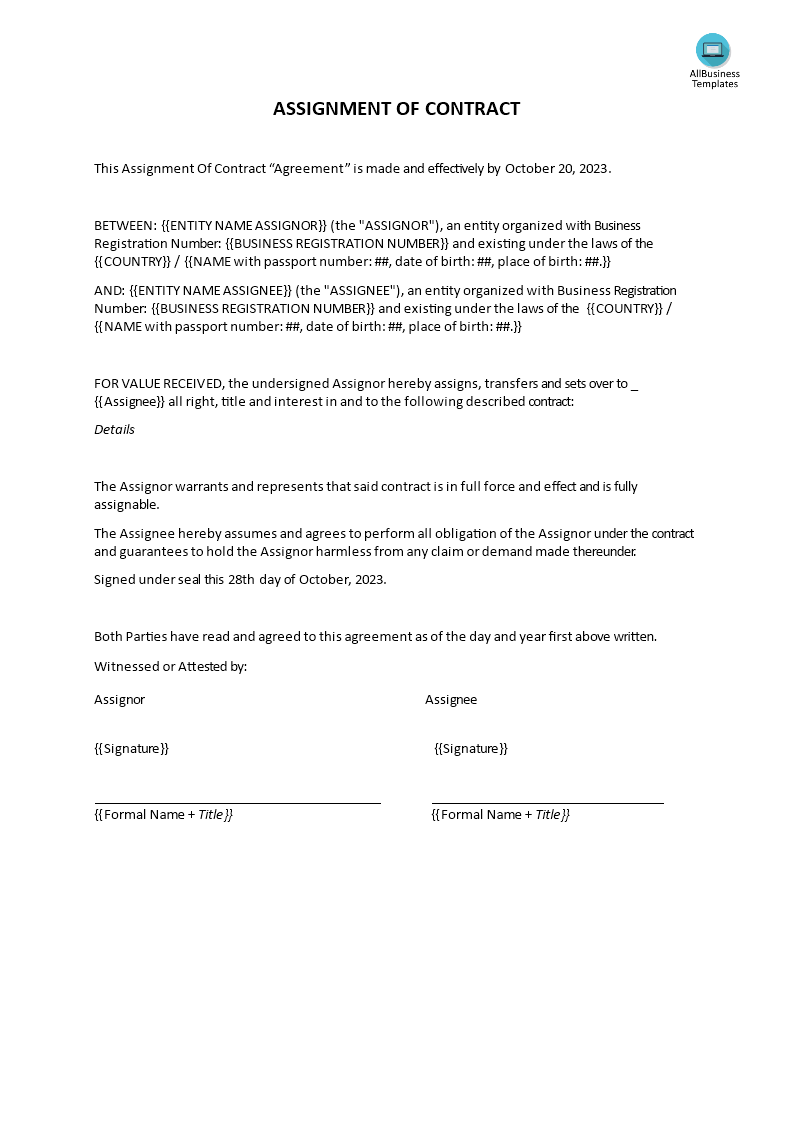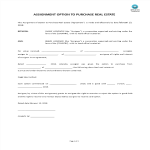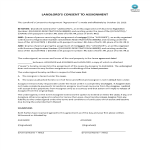Assignment of contract

Guardar, completar los espacios en blanco, imprimir, listo!
How to write an Assignment contract? How does an assignment of obligations and contracts work? Download this Assignment contract template now and see how to assign rights, title or interest to another party!
Vandaag: USD 1.99
Descárgalo ahora

Formatos de archivo premium disponibles:
.docx- Este documento ha sido certificado por un profesionall
- 100% personalizable
Business Negocio Legal Jurídico assignment asignación assignment of contract cesión de contrato assignment contract contrato de cesión
How to write an Assignment contract? How does an assignment of obligations and contracts work? We provide an easy-to-use template that you can download and customize for your needs. Our templates are available in PDF, Word, and Excel formats, so you can choose the format that works best for you. Download this Assignment of Contract template now and see a good way to assign rights, titles, or interests to another party!
Writing an Assignment of Contract involves documenting the transfer of contractual rights and obligations from one party (the assignor) to another party (the assignee). This legal document is often used when one party to a contract wishes to delegate or transfer their rights and responsibilities to another party.
Below are the steps to write an Assignment of Contract:
- Understand the Original Contract:
- Carefully review the terms and conditions of the original contract to understand the rights, obligations, and responsibilities of the parties involved. This will help you identify what is being assigned.
- Identify the Parties:
- Clearly identify the assignor (the party transferring the rights and obligations) and the assignee (the party receiving them). Include their full legal names and addresses.
- Introduction:
- Start the document with a clear title, such as "Assignment of Contract," followed by the date of the assignment.
- Recitals:
- Include a section of "Recitals" or "Whereas" clauses that provide context and background information. This can explain the original contract, the intent to assign, and the reason for the assignment.
- Assignment Details:
- Clearly state that the assignor is assigning all of their rights, benefits, and obligations under the original contract to the assignee. Include specific details about the original contract, such as its title, date, and parties involved.
- Consideration:
- If there is any consideration (compensation or something of value) being exchanged as part of the assignment, specify the amount or terms.
- Representations and Warranties:
- Include a section where both the assignor and assignee make certain representations and warranties. These may include statements about their authority to enter into the assignment and their understanding of the original contract.
- Consent and Approval:
- If the original contract requires the consent or approval of the other party (the non-assigning party) to the assignment, state that the necessary consent has been obtained.
- Governing Law:
- Specify the governing law that will apply to the assignment. This is often the same as the governing law in the original contract.
- Signature and Date:
- Provide space for the assignor and assignee to sign and date the document. Each party should sign in the presence of a witness or a notary public if required by local law.
- Execution and Delivery:
- Include a clause stating that the document is effective upon execution and delivery. This means that the assignment takes effect once both parties have signed and exchanged the document.
- Notices:
- Include a section that specifies where and how notices related to the assignment should be sent.
- Attachments:
- If necessary, attach a copy of the original contract as an exhibit to the Assignment of Contract document.
- Legal Review:
- Consider having the Assignment of Contract reviewed by legal counsel to ensure compliance with relevant laws and regulations and to address any specific requirements of the original contract.
Distribution:
Provide copies of the signed assignment to all relevant parties, including the non-assigning party (if required).
Remember that contract laws can vary by jurisdiction, so it's important to consult with legal professionals familiar with the laws in your area when drafting and executing an Assignment of Contract. Additionally, obtaining the necessary consent from the non-assigning party (if required by the original contract) is crucial to ensure the assignment is valid and enforceable.
Using our business templates guarantees you will save time, cost, and effort!
Fast, safe, and easy!
DESCARGO DE RESPONSABILIDAD
Nada en este sitio se considerará asesoramiento legal y no se establece una relación abogado-cliente.
Deja una respuesta. Si tiene preguntas o comentarios, puede colocarlos a continuación.


